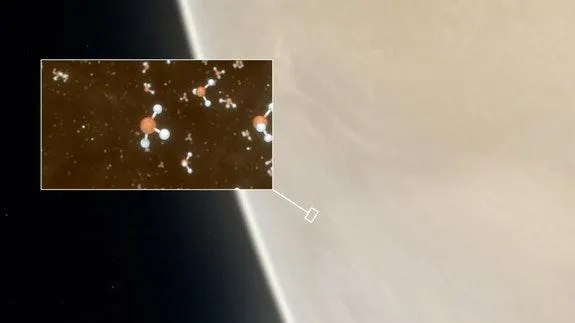In Clouds on Venus, New Potential for Microbial Life
Astronomers have detected a chemical in Venus’ atmosphere that signifies life on Earth. Could it mean the same on Venus?
/https://tf-cmsv2-smithsonianmag-media.s3.amazonaws.com/filer/30/e7/30e764a5-24fd-4b9b-8ca2-15e05525da3e/manoa-ifa-nasa-venus-wide.jpg)
A small amount of a certain stinky gas in Venus’ clouds has astronomers abuzz. In a paper published today in Nature Astronomy, astronomer Jane Greaves of Cardiff University and her team have announced that they detected a small amount of phosphine high in Venus’ cloudy atmosphere.
On Earth, phosphine is produced by bacteria in oxygen-starved environments such as swamps or wetlands. As Ashley Strickland notes for CNN, it’s also known for its overpowering odor, which has been compared to rotting fish or garlic.
The presence of this gas in Venus’ clouds might be a hint of life on our closest planetary neighbor, the team announced Monday. As the New York Times reports, the researchers have not actually confirmed the presence of any bacteria on the planet, and additional observations and a trip to Venus would be necessary to confirm the presence of any hypothetical life forms.
However, after working through and discounting many possible causes, the team could come up with no other satisfactory explanation for phosphine’s presence in Venus’ atmosphere, as Nell Greenfieldboyce reports for NPR. In their view, some kind of living thing could—emphasis on “could”—be producing the chemical.

“As crazy as it might sound, our most plausible explanation is life,” molecular astrophysicist and study co-author Clara Sousa-Silva tells the Atlantic’s Marina Koren.
On the other hand, the phosphine could be the result of an unknown chemical process that scientists don’t currently understand, as the Times reports. What’s certain is that astronomers will need to conduct further studies on Venus’ atmosphere.
“We know that it is an extraordinary discovery,” Sousa-Silva tells the Times. “We may not know just how extraordinary without going back to Venus.”
Sometimes referred to as our “sister” planet for its proximity to Earth and its similar size, Venus is notoriously inhospitable. The planet’s surface averages a scorching 800 degrees Fahrenheit, and is covered in thick clouds of caustic sulfuric acid. (As Koren notes in the Atlantic, if a rover were ever sent to Venus, it would melt on its surface in “minutes.”) Viewing Venus as a relatively unlikely candidate for hosting life, astronomers have long searched for evidence of life elsewhere, such as on Mars and Jupiter’s icy moons, the Times notes.
However, scientists have hypothesized that the planet’s yellow, hazy clouds might provide a more suitable habitat for life compared to its hellish surface. About 30 miles above Venus’ surface in the upper cloud deck, the pressure and heat are less intense, per NPR.
Greaves and her team focused their study on these clouds. The researchers studied the planet using the James Clerk Maxwell Telescope (JCMT) in Hawaii and the Atacama Large Millimeter/submillimeter Array (ALMA) telescope in Chile, in 2017 and 2019 respectively, per a Cardiff University statement.
The team detected phosphine in Venus’ clouds at a concentration of 20 parts per billion, the authors write in the study. “I was very surprised—stunned, in fact,” Greaves tells Reuters.
Greaves and her team went through each possible explanation for the presence of phosphine in Venus’ clouds that they could think of—volcanoes, lightning strikes, even meteorites from outer space—and ruled them out, reports Seth Borenstein for the Associated Press. Finally, the team tentatively settled on the last, most tantalizing explanation: alien life.
Yet Greaves, her team and many outside experts all agree that the study in no way constitutes proof of life on another planet.
“It’s not a smoking gun,” study co-author David Clements, an astrophysicist at the Imperial College of London, tells the AP. “It’s not even gunshot residue on the hands of your prime suspect, but there is a distinct whiff of cordite in the air which may be suggesting something.”
“I’m skeptical,” Sousa-Silva tells the Atlantic. “I hope that the whole scientific community is just as skeptical, and I invite them to come and prove me wrong, because we’re at the end of our expertise.”
NASA astrobiologist Giada Arney—who studies Venus, but was not involved in this study—tells NPR that scientists still have much to learn about Venus’ atmosphere. “If there’s life in the Venus clouds, that would be extraordinary,” she says. However, “there is much about Venus we still don’t understand, or that we understand poorly. It’ll take the combined work of the Venus and astrobiology communities to answer this important question fully.”
Similarly, Cornell University astronomer Lisa Kaltenegger, who is not an author on this new paper, tells the AP that the idea of phosphine as a biomarker is exciting, but that scientists don’t know enough about Venus to conclusively say that it points to life.
“The finding itself is astonishing,” Paul Byrne, a scientist at North Carolina State University in Raleigh who was not involved in the research, tells the Times. He notes that he is “skeptical of it being life,” but adds: “I don’t have a better explanation for what it is.”
In a statement, NASA noted that it was “not involved in the research and cannot comment directly on the findings.”
“[H]owever, we trust in the scientific peer review process and look forward to the robust discussion that will follow its publication,” the organization added.
As the Atlantic and the Times report, this study isn’t the first to raise the question of life in Venus’ clouds: Famed scientists Harold Morowitz and Carl Sagan proposed the idea in 1967, more than half a century ago.
/https://tf-cmsv2-smithsonianmag-media.s3.amazonaws.com/accounts/headshot/nora.png)


/https://tf-cmsv2-smithsonianmag-media.s3.amazonaws.com/accounts/headshot/nora.png)